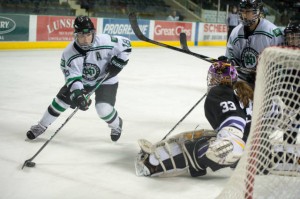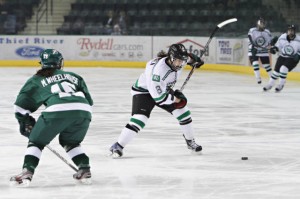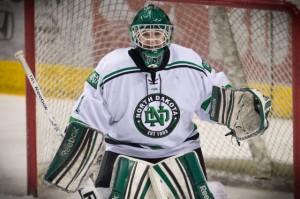Brian Idalski has coached the North Dakota’s women’s team for six seasons now, turning a club with zero wins into a highly competitive team on a national level. UND has now strung together three consecutive winning seasons, setting program records for wins in each of those three years and earning its first two berths in the NCAA Tournament in 2011-2012 and 2012-2013.
A big reason for the team’s dramatic turn-around was the transfer of Jocelyne and Monique Lamoureux to North Dakota after their freshman season. They have undoubtedly made a lasting impact on the program. “There’s very few kids who have stepped right into college hockey as freshmen and been dominant players…but they were fantastic putting points up on the board right away as freshmen,” Idalski said to The Hockey Writers in a recent interview. With their hard work on and off the ice, as well as in the classroom, they epitomized what the program wants from its players. “You can’t ask for a better example of what we strive to be,” he said.

“They’re not afraid to make the play and try things, and they have a lot of confidence in themselves and that just comes from the amount of time and effort that they put into working on their game. And it’s so cliché to say but they spent more time here than any other players,” said Idalski. “They didn’t need to, they were already really good, but they still, and everyone on our team knew it, put more time in than anybody else.”
Overall, though, their effect on the team as a whole is what means the most. Said Idalski: “When you look at the Lamoureuxs’ time, what made them special was they took a team that was pretty deficient defensively and really wasn’t very solidified in goal and made us competitive.”
Replacing Jocelyne’s offense up front and Monique’s points and minutes on the back-end certainly won’t be easy, but Idalski feels his team is capable of doing so. In fact, he believes that the Lamoureuxs’ graduation might actually benefit certain players. “It’s an interesting dynamic for us because we know that there are a lot of kids who we didn’t get as much out of as we think we could’ve, because they leaned on [Jocelyne] to do things,” he said. “So now those kids, without that shadow perhaps, have to take another step forward and do more themselves and not wait around for somebody else to do it.”
As far as replacing Monique’s contributions on defense, Idalski also expects several different players to step up, including incoming freshmen Gracen Hirschy, a member of the U.S. Under-18 team last year, and Halli Krzyzaniak, a two-time gold medalist with Canada’s Under-18 team. “[Hirschy’s] very athletic, and has some of those qualities that Monique had as far as being able to beat somebody coming out of the zone and on the rush,” said Idalski. He called Krzyzaniak “the real deal”, saying she’s “probably the best D recruit we’ve ever landed”; he expects her to log a lot of minutes next year. Idalski expects the addition of Johanna Fallman, who was ineligible last year, to also help, as well as the growth of returning players such as Sam Lashomb and Tanja Eisenschmid.

One player in particular who will help to replace the Lamoureuxs’ production is forward Michelle Karvinen, who scored 18 goals and 47 points in 27 games last year. “In a lot of regards, it becomes Michelle’s team just because of how talented she is as a player,” Idalski said. “There’s no doubt she’s going to have to step up as far as offensively and she’ll probably be the focal point for a lot of teams defensively.” He also spoke to her character off the ice. “Having an opportunity to coach some pretty elite kids, it’s amazing how humble she is and just what a genuinely nice person Michelle is. So I’m really excited for her. I think she has an opportunity to be a Patty Kaz finalist; I think she has an opportunity to lead us in a lot of regards to a championship, not only in the league but nationally.”
One of the most intriguing things about Karvinen is her European background. Born in Rodovre, Denmark, she is a dual citizen of Denmark and Finland and competes internationally with the Finns. There were five other European players on North Dakota’s roster last year, and that’s far from a coincidence.
Having grown up in Detroit, Idalski is a huge Red Wings fan and saw firsthand how the team became one of the NHL’s first to push into Europe. “I was always very curious,” he said, once Detroit started winning with the Russian Five and their influx of Swedes. After also noting how successful Minnesota-Duluth’s program was with their Swedish players, Idalski first went overseas to assist now-associate head coach Peter Elander with camps. He was amazed with the training being so skill-driven. “For a 50-minute practice, they basically did the same drill. After 20 minutes, they would change one aspect, add a shot or add a pass, do it for another 20 minutes, then would add one more aspect, another shot, another pass.”
“A lot of the Europeans coming over is a credit to Peter and Erik Fabian and my staff as a whole for having a little bit of a network and for knowing people over there and being able to recruit,” he said. “But the reason we went over there is you can’t pull out the twelfth-best American forward and the twelfth-best Canadian and hope to compete. You just couldn’t do it. So we were pushed a little bit overseas just to have an opportunity for some high-end talent, and we were lucky to do pretty well over there with a few kids.”
Idalski also believes that more European players coming over to compete in the NCAA could help improve the quality of the international game. “I think there’s no doubt the more that players come over and play in this environment that it’s going to help when they go back and play for their countries and help some of those countries develop their player pool, because there’s not a lot of opportunities for a lot of them to compete at a high level back home.”
All of North Dakota’s incoming freshmen, of all nationalities, are expected to make an impact for the team this year, but perhaps not without some struggle. “It’s very hard for a rookie at most levels to maintain the consistency for a full season. It’s either a struggle and they figure it out and end really well or they start really well and then kind of fade, and it’s very interesting,” said Idalski. That kind of inconsistency can be attributed to the competitiveness of games and practices in the NCAA. “If you go back statistically and look, a perfect example of this is Hannah Brandt and Meghan Dufault,” he said. Brandt, as a freshman at Minnesota, averaged .78 less points per game after January 1st, whereas Dufault, as a rookie at North Dakota, averaged 1.1 more points per game after January 1st.
Brandt certainly had an outstanding 2012-2013 campaign anyway, as did the rest of the Gophers, who went undefeated en route to repeating as WCHA and national champions. “They earned it,” Idalski said, calling their team characteristics “admirable” because of their ability to bounce back from adversity. “You never knew on what day who was going to be a hero for them, and that’s always a characteristic of a fantastic team.”
“We always felt if we could just get up 2-0, if we could just get up 3-0, we would win,” Idalski said about facing Minnesota. “But we could never get to that point. If we scored, they’d answer back. If we had three good chances, [goaltender Noora Räty] would make three unbelievable saves so we couldn’t pull away. And so that was the toughest thing.” Still, though, he has a lot of respect for the special season that they had. “I hope they’re still out enjoying it, in fact,” he joked.
With nine of the top 12 scorers in 2012-2013 either graduating or competing with their national teams this year, there will be an adjustment for Minnesota and many other top teams. But just how much does that change the national outlook heading into the year? “I know people would love for things to be more competitive top to bottom and look for that in the Olympic year, but at the end of the day, I don’t know how much it’s going to change,” Idalski said. “It’s very interesting to me that that culture doesn’t really change. Teams that have a history of winning expect to win and still find ways to win. So Minnesota’s still going to be really good. Wisconsin’s still going to be really good. BC, BU are still going to be really good. They may drop one more game to somebody beneath them that maybe traditionally they would’ve handled, but they’re still going to find a way at the end of the year to win hockey games because they expect to win and their culture is strong.”
As for his own team, Idalski feels that North Dakota’s roster is, top to bottom, “more equal in talent than it’s ever been”, and that the team has especially made strides on the blue line and in goal. “Until the end of last year, our goaltending the past few years had been inconsistent; our D corps wasn’t really national team, Olympic-caliber players. It was more of a gritty, physical, throw the puck off the glass kind of D who competed. Now we’ve transitioned more into a puck-possession talent D corps.” Even with Monique gone, he believes that UND’s defense is deeper and more talented than ever.

But the improvements in goal have been crucial to the team’s success. “It’s an old coaching joke, but it’s true: if you want to be a good coach, get a good goalie,” said Idalski. He feels that’s exactly what he has in sophomore netminder Shelby Amsley-Benzie. “She really was fantastic at the end of the year and we don’t beat Wisconsin, we don’t go to three overtimes against Minnesota without her finding her game and getting very comfortable being our number one goalie.”
The biggest difference for the team with Amsley-Benzie in net is her presence. “The goalie’s personality, more than anything else, speaks to the team. There were a couple of games you could tell our kids were a little nervous in net and they weren’t handling the puck as sharply or crisply as you would like and that just kind of feeds panic throughout the whole team,” Idalski said. He mentioned current U.S. national team goaltender and former Badger Jessie Vetter as being “one of the best” in that department. “She could give up a bad goal and she would just kind of be like ‘my bad’ and shrug it off, and everyone knew she was going to get the next one.”
“Shelby showed that towards the end of the year and that’s probably the thing that made me the most excited, was that permeated through the rest of the club. People knew that she was ready to play and she was going to make the save that she was supposed to and if we didn’t execute it like we thought we could, we could win hockey games,” he said.
Is North Dakota ready to take the next step and win a title? “I would think so,” said Idalski. “Even when it was totally unrealistic, we talked about [how] this program should win championships. This program, like our men, is judged on winning championships. And so each year we’ve been able to improve. Each year we have gotten better and so that’s the next step.”
Awesome article Gabriella.
Thanks Eric!